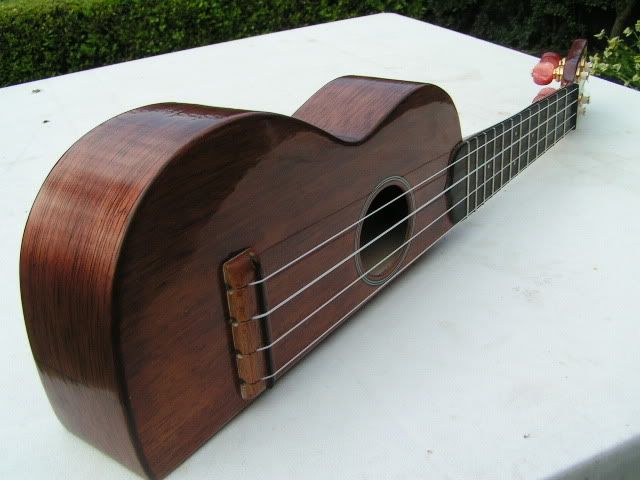greenscoe
Well-known member
New builders may find making a mold a daunting task. I dont know what other hobby makers do, but this is how I go about it.
First I decide on the box shape and make a paper/card pattern which I transfer to wood. Here I've used an old drawer side -others might use a new piece of plywood: I sprayed paint to get a shadow on the wood rather than drawing around my paper pattern. I then cut out the wooden master pattern -use a jig saw or bandsaw-and cleaned it up with hand tools until I was entirely happy it was the shape I wanted. My master pattern is a little more than half the box shape with the half way clearly marked-I'll explain later.

My master pattern is then used to create a number of half mold slices. Again I used scrap wood, plywood would be better. The master pattern is copied onto the wood slices and again each is sawn out roughly with jig or band saw. I made 8 slices in total -only 2 slices shown here.

Now for the clever part. The master pattern is then screwed to each roughed out half mold slice in turn. Then using a router (with or without router table) and a bearing guided template profiler bit, exact copies of the master pattern are made to be half mold slices. The reason the master pattern is slightly more than half the mold is that the profiler bearing needs the extra shape to follow in order to cut each end of the half mold slice accurately. I recently bought this router table for £30 from Aldi but its not necessary: holding the wood and moving a router achieves the same result. In the photos the master pattern is the old drawer side, the half mold slice is the yellow pine-notice the bearing which follows the master pattern.


The 4 per side half molds slices are glued/screwed together in a thick sandwich. The 2 halves of the mold can be joined at the ends with wood as here or other means such as quick release clips. Its necessary to separate the 2 halves to extract the box after gluing on the back and top.

In theory it should be perfect but checks should be made to ensure the the mold is true/square. In practice a little cleaning up/adjustment may be required. I use car body filler for this. The overall size of the mold can be reduced to ensure your F clamps reach the box whilst retaining its structural integrity. Finally the mold should be sealed with several coats of varnish.
This mold is 13.25" long for 20/22" scale length instruments. It took me about 10 hrs to complete-my material costs were negligible.
See next post for first use of the mold this morning and a photo of my tenor mold, made in February this year by the same method only without a router ie entirely with hand tools.
First I decide on the box shape and make a paper/card pattern which I transfer to wood. Here I've used an old drawer side -others might use a new piece of plywood: I sprayed paint to get a shadow on the wood rather than drawing around my paper pattern. I then cut out the wooden master pattern -use a jig saw or bandsaw-and cleaned it up with hand tools until I was entirely happy it was the shape I wanted. My master pattern is a little more than half the box shape with the half way clearly marked-I'll explain later.

My master pattern is then used to create a number of half mold slices. Again I used scrap wood, plywood would be better. The master pattern is copied onto the wood slices and again each is sawn out roughly with jig or band saw. I made 8 slices in total -only 2 slices shown here.

Now for the clever part. The master pattern is then screwed to each roughed out half mold slice in turn. Then using a router (with or without router table) and a bearing guided template profiler bit, exact copies of the master pattern are made to be half mold slices. The reason the master pattern is slightly more than half the mold is that the profiler bearing needs the extra shape to follow in order to cut each end of the half mold slice accurately. I recently bought this router table for £30 from Aldi but its not necessary: holding the wood and moving a router achieves the same result. In the photos the master pattern is the old drawer side, the half mold slice is the yellow pine-notice the bearing which follows the master pattern.


The 4 per side half molds slices are glued/screwed together in a thick sandwich. The 2 halves of the mold can be joined at the ends with wood as here or other means such as quick release clips. Its necessary to separate the 2 halves to extract the box after gluing on the back and top.

In theory it should be perfect but checks should be made to ensure the the mold is true/square. In practice a little cleaning up/adjustment may be required. I use car body filler for this. The overall size of the mold can be reduced to ensure your F clamps reach the box whilst retaining its structural integrity. Finally the mold should be sealed with several coats of varnish.
This mold is 13.25" long for 20/22" scale length instruments. It took me about 10 hrs to complete-my material costs were negligible.
See next post for first use of the mold this morning and a photo of my tenor mold, made in February this year by the same method only without a router ie entirely with hand tools.
Last edited:





